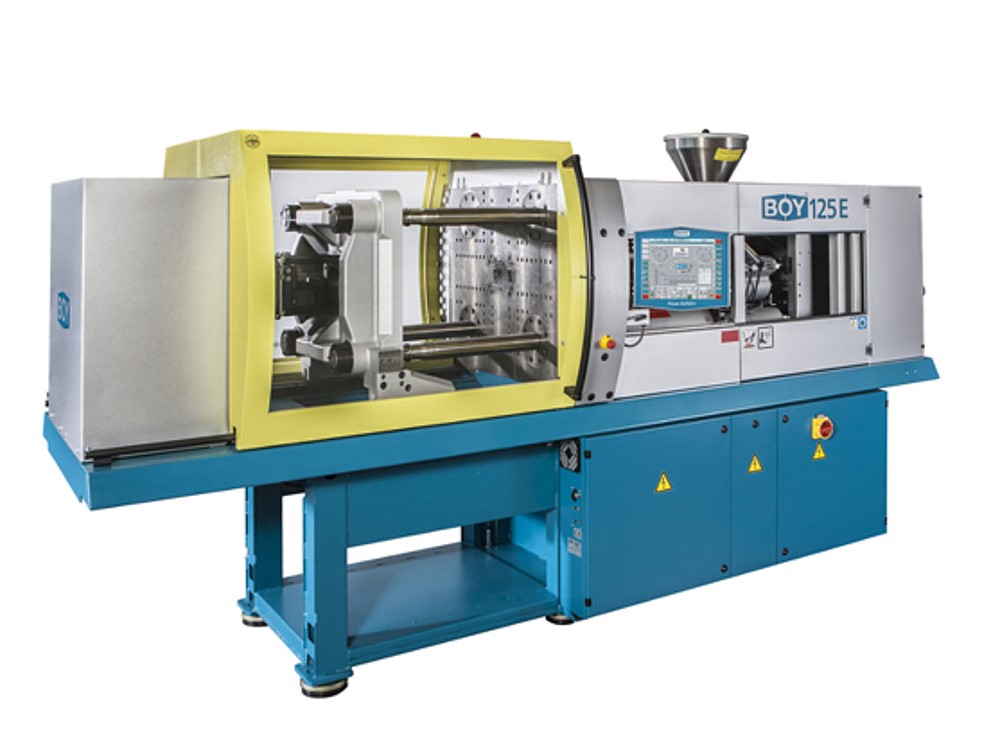Injection moulding production on a minimised floor space

The production of injection-moulded plastic components with the lowest possible requirement of the general shortage of production areas - this has been BOY‘s “credo” since the foundation of the company many years ago.
With its injection moulding machines in the clamping force range between 63 and 1250 kN, BOY convinces the plastics processing industry with the smallest footprints, high dynamics and energy efficiency. The injection moulding machines of the medium-sized company located in Neustadt-Fernthal are differing amongst others from the models of their market competitors by their compact design.
As an example: the dimensionally smallest injection moulding machine with 100 kN clamping force (BOY XS) requires a floor space of only 0.78 m². Even the largest BOY model - the BOY 125 E with 1,250 kN clamping force - has a footprint of only 5.22 m².
The basis for this more compact design is the two-platen clamping system used in all BOY injection moulding machines.
This extremely short design compared to conventional three-platen machines has another significant advantage. The space below the cantilevered two-platen clamping unit can be used for the space-saving integration of peripheral devices.
Example
The image shows a BOY 35 E in cleanroom design, with a packaging machine that was installed directly below the two-platen clamping unit. After the ejection from the mould, the injection-moulded plastic components are packed directly into foil bags and are then placed on a Z-conveyor belt integrated below. The total floor space required of this automated production unit is just below two square metres without the conveyor belt.
In addition to the more compact dimensions, the two-platen clamping unit works much more dynamically and energy-efficiently due to its low moving masses. There are good reasons that BOY‘s injection moulding machines consistently have a very good energy classification according to Euromap 60.1, reaching up to the top value of 9+ (energy consumption of < 0.31 kWh/kg processed material).
Alfred Schiffer, Managing Partner of Dr. BOY GmbH & Co. KG, explains the BOY philosophy with an example from the USA: „A long-standing customer of ours has hundreds of BOY 22 A and BOY 25 E machines in the production hall standing closely together. If these have to be replaced by new machines, they can only be lifted out of the production area by an indoor crane. This manufacturer - who produces millions of special lids for plastic cups in 24-hour continuous operation - has thus made optimum use of the valuable production space and was able to position a larger number of more compact BOY injection moulding machines in the production.“
He adds: „We consequently pursue the principle of the smallest possible machine floor space when designing new injection moulding machines. Maximum compactness of the machine brings many advantages not only for us, but also for the user“, this is his conviction. A look back proves him right - BOY has been one of the established manufacturers of injection moulding machines worldwide for more than 50 years.
„The more flexible and simpler an injection moulding machine can be used in production, the more advantageous it is for the user,“ says Martin Kaiser, Technical Manager at BOY. And he is referring specifically to the smallest of the BOY injection moulding machines. Both, BOY XS and BOY XXS are already available ex works rollable with a mobile
base frame. This means that this injection moulding machine can be used completely free on and individually order-related in the production space or it can be positioned differently.
This also applies to the compact 2C-injection units from the BOY product range. By mounting thisself-sufficient injection unit to a conventional injection moulding machine, it quickly and easily becomes a multi-component injection moulding machine. „A higher flexibility in production is not possible“ is Martin Kaiser‘s statement.
The use of many compact machines in the same space instead of a few, larger machines offers yet another advantage. The risk of “unpopular” production down times of machines is significantly reduced by the simultaneous use of more compact machines in the available production space. Thus, cost-intensive machine downtimes can be avoided.
Conclusion:
Less is more - more compact is more economical
The concept of using as many injection moulding machines as possible per production hall is practised in many successful large-scale companies. Whether it is the production of toy figures of a world-renowned manufacturer located in Franconia, the aforementioned example of an American corporation or also for the many medium-sized companies in the plastics industry in the production of medical products, technical components or packaging articles - the following applies to all of them: the more production machines per production area can be used, the more cost-effective are the production and the part price of injection-moulded plastic components.

 Material Dosing and Mixing
Material Dosing and Mixing Products Handling and Automation
Products Handling and Automation

